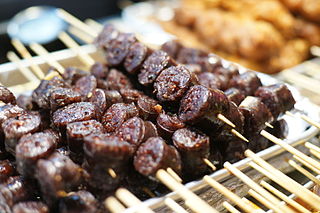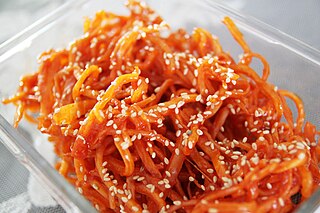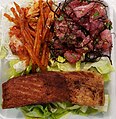
Fried rice is a dish of cooked rice that has been stir-fried in a wok or a frying pan and is usually mixed with other ingredients such as eggs, vegetables, seafood, or meat. It is often eaten by itself or as an accompaniment to another dish. Fried rice is a popular component of East Asian, Southeast Asian and certain South Asian cuisines, as well as a staple national dish of Indonesia. As a homemade dish, fried rice is typically made with ingredients left over from other dishes, leading to countless variations. Fried rice first developed during the Sui Dynasty in China.

Kimchi fried rice or kimchi-bokkeum-bap (김치볶음밥) is a variety of bokkeum-bap, a popular dish in South Korea. Kimchi fried rice is made primarily with kimchi and rice, along with other available ingredients, such as diced vegetables or meats like spam.

Japchae is a savory and slightly sweet dish of stir-fried glass noodles and vegetables that is popular in Korean cuisine. Japchae is typically prepared with dangmyeon, a type of cellophane noodles made from sweet potato starch; the noodles are mixed with assorted vegetables, meat, and mushrooms, and seasoned with soy sauce and sesame oil.

Poke is diced raw fish served either as an appetizer or a main course.

Banchan are small side dishes served along with cooked rice in Korean cuisine. Banchan are set in the middle of the table to be shared. At the center of the table is the secondary main course, such as galbi or bulgogi, and a shared pot of jjigae. Bowls of cooked rice and guk (soup) are set individually. Banchan are served in small portions, meant to be finished at each meal and replenished during the meal if not enough. Usually, the more formal the meals are, the more banchan there will be. Jeolla province is particularly famous for serving many different varieties of banchan in a single meal.

Dubu-kimchi (두부김치) is a Korean dish consisting of tofu (dubu) and stir-fried kimchi. Soft, warm, blanched tofu is served with well-fermented, tangy baechu-kimchi stir-fried with pork, makes a well-matched anju for either soju or makgeolli.

Tteokbokki (떡볶이), or simmered rice cake, is a popular Korean food made from small-sized garae-tteok called tteokmyeon or commonly tteokbokki-tteok. Eomuk, boiled eggs, and scallions are some common ingredients paired with tteokbokki in dishes. It can be seasoned with either spicy gochujang or non-spicy ganjang -based sauce; the former is the most common form, while the latter is less common and sometimes called gungjung-tteokbokki.

Muk is a Korean food made from grains, beans, or nut starch such as buckwheat, sesame, and acorns and has a jelly-like consistency. Muk has little flavor on its own, so muk dishes are seasoned with soy sauce, sesame oil, chopped scallions, crumbled gim, and chili pepper powder, and mixed with various vegetables.

Korean noodles are noodles or noodle dishes in Korean cuisine, and are collectively referred to as "guksu" in native Korean or "myeon" in hanja character. Preparations with noodles are relatively simple and dates back to around 6000 BCE to 5000 BCE in Asia. In Korea, traditional noodle dishes are onmyeon, called guksu jangguk, naengmyeon, bibim guksu, kalguksu, kongguksu among others. In royal court, baekmyeon consisting of buckwheat noodles and pheasant broth, was regarded as the top quality noodle dish. Naengmyeon, with a cold soup mixed with dongchimi and beef brisk broth, was eaten in court during summer.

Sundae is a type of blood sausage in Korean cuisine. It is a popular street food in both North and South Korea, generally made by steaming cow or pig's intestines stuffed with various ingredients.

Squid is eaten in many cuisines; in English, the culinary name calamari is often used for squid dishes. There are many ways to prepare and cook squid. Fried squid is common in the Mediterranean. In New Zealand, Australia, the United States, Canada, and South Africa, it is sold in fish and chip shops, and steakhouses. In Britain, it can be found in Mediterranean 'calamari' or Asian 'salt and pepper fried squid' forms in various establishments, often served as a bar snack, street food, or starter.

Bokkeum (볶음) is a category of stir-fried dishes in Korean cuisine.

Dak-dori-tang (닭도리탕) or braised spicy chicken is a traditional Korean dish made by boiling chunks of chicken with vegetables and spices. The ingredients are sometimes stir-fried before being boiled. It is a jjim or jorim-like dish, and the recipe varies across the Korean peninsula. Common ingredients include potatoes, carrots, green and red chili peppers, dried red chili peppers, scallions, onions, garlic, ginger, gochujang, gochutgaru, soy sauce, and sesame oil.

Ojingeo-chae-bokkeum (오징어채볶음) is a bokkeum made with dried shredded squid—called ojingeo-chae in Korean— and gochujang-based sauce. Like other dry banchan, it can be stored for a long time and retain its taste.

Nakji-bokkeum (낙지볶음) or stir-fried octopus is a popular dish in Korea that is relatively recent, with origins dating back only two centuries and first being introduced in the early 1960s.
Daegu or Taegu may refer to:


















